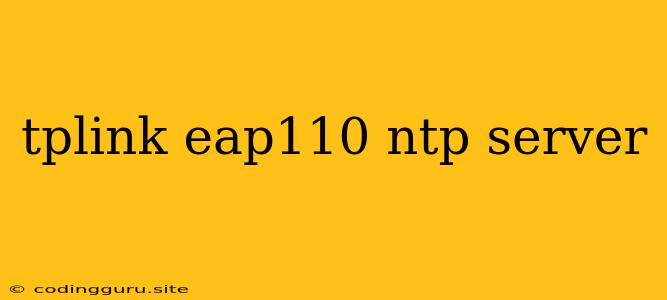Setting Up an NTP Server for Your TP-Link EAP110 Access Point
The TP-Link EAP110 is a powerful and versatile access point, but it's often used in environments where accurate time synchronization is essential. This is where the Network Time Protocol (NTP) comes in. In this guide, we will walk through the steps on how to configure your EAP110 to sync its internal clock with an external NTP server.
Why Use NTP?
Before we dive into the configuration, let's understand why NTP is crucial. Here's why you might want to configure your EAP110 to use an NTP server:
- Accurate Timekeeping: NTP ensures that your EAP110's clock is accurate and synchronized with a reliable time source. This is vital for logging, troubleshooting, and maintaining consistent time stamps across your network.
- Security: Using NTP can help you identify and investigate potential security breaches by analyzing timestamps in logs. A properly configured NTP server provides a trustworthy source for time data, reducing the risk of malicious manipulation.
- Network Management: For efficient network management, accurate time synchronization is essential for monitoring, analysis, and reporting tools.
Configuring the EAP110 for NTP
Now that we know the benefits, let's configure your EAP110 to use an NTP server.
Step 1: Access the Web Interface
- Connect your computer to the EAP110's wireless network or via an Ethernet cable.
- Open a web browser and type the IP address of the EAP110. This is usually found on the device's label or by checking your DHCP server's lease information.
- Enter the default username and password (usually 'admin' and 'admin').
Step 2: Navigate to the Time Settings
- Once logged in, navigate to the "System" or "Advanced" section of the web interface.
- Locate the "Time Settings" or "NTP" option.
Step 3: Configure the NTP Server
- NTP Server Address: Enter the IP address or hostname of your preferred NTP server. Some popular public NTP servers include:
- time.google.com
- time.nist.gov
- pool.ntp.org
- Update Interval: This specifies how often the EAP110 will try to synchronize with the NTP server. You can choose a shorter interval for more frequent updates or a longer interval to reduce network traffic.
Step 4: Save and Apply Changes
- Click the "Apply" or "Save" button to apply the changes.
- The EAP110 will now attempt to connect to the specified NTP server and synchronize its clock. You can check the "Status" or "System Information" section to verify the synchronization status.
Tips for Choosing an NTP Server:
- Reliability: Opt for reputable NTP servers that have a history of uptime and stability.
- Location: Choose a server close to your geographic location for better time accuracy and lower network latency.
- Redundancy: Consider using multiple NTP servers for redundancy. If one server becomes unavailable, the EAP110 can automatically switch to another.
Troubleshooting NTP Issues
If you encounter issues while configuring NTP, here are some common troubleshooting steps:
- Firewall: Ensure that your firewall is not blocking traffic to the NTP server on port 123.
- Network Connectivity: Verify that the EAP110 has a stable internet connection.
- Server Availability: Check if the NTP server you're using is operational. You can try alternative servers from the list above.
- Time Zone: Double-check that the time zone setting on the EAP110 is correct.
- NTP Server Address: Confirm that you have entered the correct IP address or hostname for your NTP server.
Conclusion
Setting up an NTP server for your TP-Link EAP110 ensures accurate timekeeping, improves security, and streamlines network management. By following these steps, you can easily configure your EAP110 to synchronize its clock with a reliable time source. Remember to use reliable servers, check for network connectivity, and address any potential firewall issues for optimal performance.
